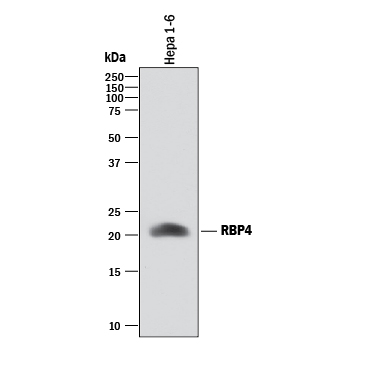Mouse RBP4/Retinol-Binding Protein 4 Antibody Summary
Glu19-Leu201
Accession # Q00724
Applications
Please Note: Optimal dilutions should be determined by each laboratory for each application. General Protocols are available in the Technical Information section on our website.
Scientific Data
 View Larger
View Larger
Detection of Mouse RBP4/Retinol‑Binding Protein 4 by Western Blot. Western blot shows lysate of Hepa 1-6 mouse hepatoma cell line. PVDF membrane was probed with 0.2 µg/mL of Sheep Anti-Mouse RBP4/Retinol-Binding Protein 4 Antigen Affinity-purified Polyclonal Antibody (Catalog # AF3476) followed by HRP-conjugated Anti-Sheep IgG Secondary Antibody (Catalog # HAF016). A specific band was detected for RBP4/Retinol-Binding Protein 4 at approximately 22 kDa (as indicated). This experiment was conducted under reducing conditions and using Immunoblot Buffer Group 1.
Reconstitution Calculator
Preparation and Storage
- 12 months from date of receipt, -20 to -70 °C as supplied.
- 1 month, 2 to 8 °C under sterile conditions after reconstitution.
- 6 months, -20 to -70 °C under sterile conditions after reconstitution.
Background: RBP4/Retinol-Binding Protein 4
Retinol (also known as vitamin A) is unstable and insoluble in the aqueous solution. However, retinol becomes quite stable and soluble in plasma due to its tight interaction with retinol-binding protein 4 (RBP4), also known as plasma retinol-binding protein (1 - 3). A prototypic member of the lipocalin superfamily, RBP4 has a beta ‑barrel structure with a well-defined cavity. It is secreted from the liver, a process requiring the availability of retinol. RBP4 delivers retinol from the liver to the peripheral tissues. In plasma, the RBP4-retinol complex interacts with transthyretin (TTR), also known as thyroxine-binding protein and prealbumin. The retinol-RBP4-TTR complex prevents the loss of RBP4 by filtration through the kidney and increases the stability of the retinol-RBP4 complex. Defects in RBP4 cause retinol-binding protein deficiency, which affects night vision. Serum RBP4 levels are elevated in insulin-resistant mice and humans with obesity and type 2 diabetes, implying that RBP4, an adipocyte-derived signal, may be a biomarker and a drug target for the two diseases.
- Zanotti, G. and R. Berni (2004) Vitamins and Hormones 69:271.
- Newcomer, M.E. and D.E. Ong (2000) Biochim. Biophys. Acta 1482:57.
- Yang, Q. et al. (2005) Nature 436:356.
Product Datasheets
FAQs
No product specific FAQs exist for this product, however you may
View all Antibody FAQsReviews for Mouse RBP4/Retinol-Binding Protein 4 Antibody
There are currently no reviews for this product. Be the first to review Mouse RBP4/Retinol-Binding Protein 4 Antibody and earn rewards!
Have you used Mouse RBP4/Retinol-Binding Protein 4 Antibody?
Submit a review and receive an Amazon gift card.
$25/€18/£15/$25CAN/¥75 Yuan/¥2500 Yen for a review with an image
$10/€7/£6/$10 CAD/¥70 Yuan/¥1110 Yen for a review without an image


